
As summer approaches, it's time to embrace the vibrant and refreshing world of rosé wines. These delightful pink-hued wines offer a spectrum of flavors, from crisp and dry to fruity and luscious.
Whether you're hosting a backyard barbecue, lounging by the pool, or enjoying a picnic in the park, a glass of rosé is the perfect companion. In this blog post, we'll explore some fantastic rosé wines that are sure to elevate your summer experiences.
Welcome back, Rosé and Summer!

Rosé: More Reassuring Than Ever
The ever-increasing popularity of rosé will grow even more this summer. Since the rise of COVID-19, wine drinkers want comfort wine, the wine they know and love.
Easy drinking, uncomplicated, and a joy to look at, rosé is the ultimate comfort wine. And because it pairs so well with almost any food, everyone loves it.
Inexpensive and available everywhere, it’s no wonder Rosé All Day became an actual brand.
If you want to know more about rosé, read on.
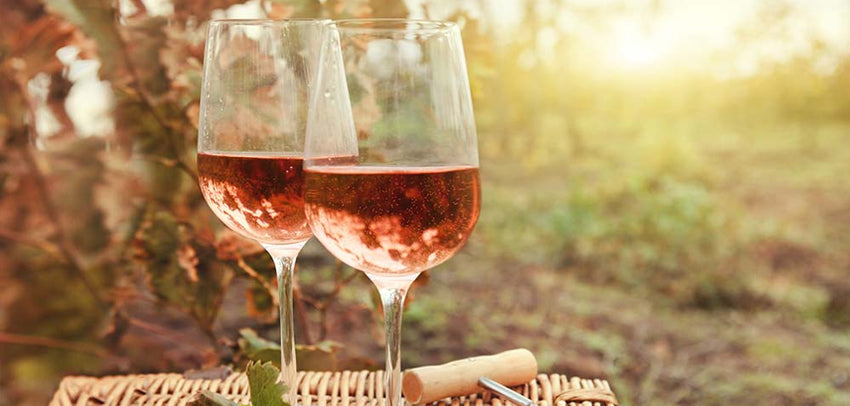
A Bit of History About Rosé
You might think rosé came from France, but there is evidence that pink wines were made in ancient Georgia, the true motherland of wine.
Most wines, red and white, were actually pink or orange in color due to primitive winemaking techniques. Without knowledge of maceration, winemakers pressed grapes right off the vines, used spontaneous fermentation, then put the wine into barrels.
Since the juice from the grapes didn’t spend much time in contact with the skins, the wine was very light in color, tannin, and body. These wines were not made for aging, but for drinking and enjoying young.
If your grandfather made wine, he might have made wine like this. Because it was considered an everyday beverage, lighter, fruitier wine was perfect for the table. And it was common practice to add water to the wine. as Thomas Jefferson sometimes did.
Light red wines, prized by French Kings, were common in the Camargue and Tavel regions. Even the famous “claret,” precursor to today’s Bordeaux, was a much lighter wine back in the day.
Wine in Champagne was actually still and pink at that time. White and sparkling did not appear until winemaking advances in the 17th century.
The king of rosé is the Provence region of France and includes Côtes de Provence, Coteaux d'Aix-en-Provence, and Bandol. These regions made rosé wine for generations. Not exported until modern times, Provence rosé is now the most popular rosé around the world.
Older folks in the US will remember Lancers and Mateus rosé. Both light, sweet and fizzy, these Portuguese wines exploded after entering the US market in the early-1940’s.
Lancers, developed by famed family-owned José Maria da Fonseca, came in a mock clay style bottle. Mateus, created by founder Fernando van Zeller Guedes, had a squat oval bottle fashioned after a soldier’s flask. Both were staples in the US after WWII. Today, Mateus is made in a drier style.
In the late 1800s, California made some rosé style wine, but the 1975 launch of the insanely popular semi-sweet White Zinfandel from Sutter Home ushered in a new era for “blush” wine, a term trademarked in 1978.
To intensify red Zinfandel while at Sutter Home, Bob Trinchero pulled some juice from macerating grapes. He sold this wine as “White Zinfandel,” believing the term rosé had a negative image. Newer versions of Zinfandel rosé go by the name “White Zin.”
As US wine drinkers learned more about wine, they began to understand the difference between sweet blush wine and dry rosé. The wine trade began to promote rosé, and production increased around the world to meet demand.
Today, the rosé category primarily consists of dry still and sparkling wine.
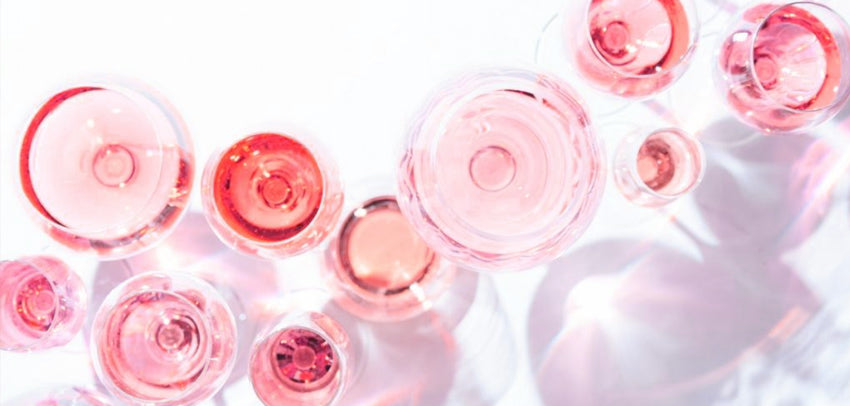
The Craft of Rosé
Making rosé may seem mysterious, but it’s simple to understand. Most rosé comes from red or black grapes. Though uncommon, it can be made from white grapes by adding red wine for color.
Rosé can be made from: Cabernet Sauvignon, Pinot Noir, Grenache, Carignan, Syrah, Mourvedre, Sangiovese, Cinsault, Malbec, Cabernet Franc, Merlot, Tempranillo, Zinfandel, Counoise, Gamay, Pinot Gris, and other grapes.
Different red grapes can also be blended together to make rosé. In France, AOC rules define which grape varieties can be used for rosé.
Not surprisingly, France, the US, and Italy produce the most rosé, but the US and France drink the most. Today, the French drink more rosé than white wine.
Rosé is made in almost every wine-producing country. Beyond Europe, there is rosé from Australia, New Zealand, South Africa, North America, and South America. You can even find rosé made in England and in India. Maybe China will release one soon.
While the term rosé is most common, you’ll see local equivalents such as “rosato” in Italy, “rosado” in Spain, and Weißherbst in Germany. Regions such as Tavel or Bandol typically do not use the word rosé on the label.
There are three production methods for rosé:
Blending
This is the simplest and easiest but it is not common. You take a white wine and add some red wine to get the color and flavor profile you want. Adding more red wine darkens the color.
This method is used for making sparkling rosé, including Champagne. Sparkling rosé has an added dosage of red wine to get the color.

Maceration
When using this process, the winemaker intends only to make rosé. By crushing red grapes and leaving the juice in contact with the skins for some time, the white grape juice takes on color from the skins.
The longer the skins are in contact with the juice or must, the darker the color. Timing can range from a few hours to a few days. The winemaker then drains the must and starts fermentation. Maceration is the most common method of producing rosé.
Saignée
This French term is from the verb “to bleed.” This method creates a red wine and a rosé.
When making red wine, the juice stays in contact with the skins for a long time. Early on during maceration, some of the must is “bled” or drained out of the tank. The drained must ferments into rosé, while the rest of the juice remains on the skins for the red wine.
You see this method often in California because bleeding off some juice concentrates the remaining must for the red wine.
In France, a method called Vin Gris (gray wine) creates an extremely light-colored wine. After lightly pressing the grapes, the must is separated from the skins when just a hint of color appears.
Styles of Rosé
One of the main reasons you love rosé is because it is so refreshing and easy to drink, so the most popular vintage is the current one. It’s rare to find rosé in the market older than two or three years.
However, some winemakers create rosés that can age up to five years. Rosé from Rioja in Spain is subject to aging requirements depending on the classification. The best-aged rosé would be rosé Champagne.
Most rosé made around the world is dry, but you can find sweeter versions, especially in the US. The drier styles will taste fresher and show more complexity.
Each grape variety yields a different style, with the rosé version lighter yet similar in style. The darker the rosé, the more tannins in the wine, so these pair better with food. Lighter rosé drinks easier and is more enjoyable with lighter fare or on its own.
With such a wide range of flavor and color, everyone can find a rosé they love. Below is a general style guideline, but exceptions abound. You’ll find many of the same characteristics across categories.
- Fruity/Floral Character – bright, light, high acid, fresh red berries, melon, citrus
- Grapes: Grenache, Sangiovese, Mourvedre, Pinot Noir, Gamay, Malbec
- Regions: Provence, Bandol, US, Italy, Argentina
- Herbal/Spicy Character – bright, high acid, fresh red/purple berries, savory, dried herbs
- Grapes: Tempranillo, Syrah, Cabernet Sauvignon, Cinsault, Cabernet Franc
- Regions: French Tavel, Spanish Rosado, Italian Rosato, US
- Sweeter/Floral Character – medium acidity, tropical fruits, cooked red berries
- Grapes: Zinfandel, Merlot, Moscato
- Regions: US, Italy
The best way to decide is to try different wines, from light in color to dark, from bone dry to sweet, from a current vintage to an aged one.
A note here about “orange” wine. Do not confuse orange wine with rosé. In making orange wine, white grapes, instead of red, macerate on the skins. The color compounds in the skins of white grapes differ from those of red grapes so the wine is more orange color than pink.
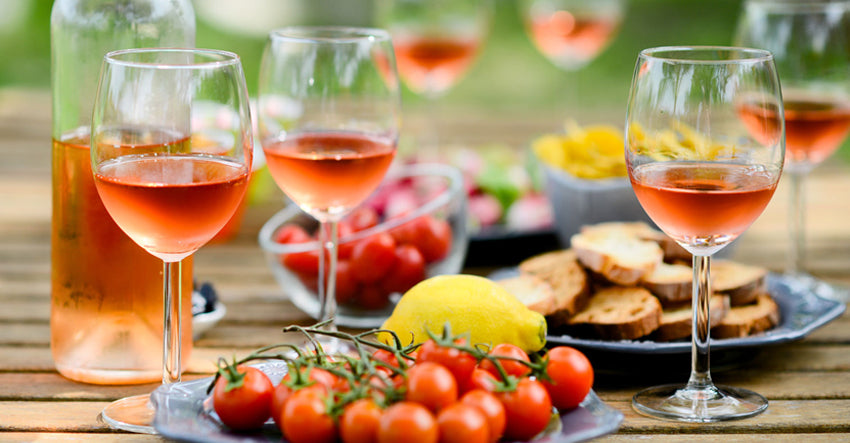
Rosé and Food
While rosé is the perfect wine to drink by the pool or sip on the porch, it is also the ideal food wine. Many rosé wines are crafted to serve with food, such as the darker wine of Tavel in southern France.
Try drinking rosé with lighter foods such as seafood, fish like salmon or tuna, vegetables, light meats, and salads. Brunch is a great time to enjoy rosé because it enhances both the meal and the fun.
With high acidity levels, rosé freshens your palate when eating fried foods or those with richer, buttery sauces. Rosé doesn’t work well with heavy dishes, though it can perk up a simply prepared steak.
The key to matching rosé and food is to match the sweetness of both. The fruitiness of these wines works well with spicy dishes.
Think about barbecue: sweet, savory, spicy, rosé stands up so well with barbecue, especially an off-dry style. Try it with ethnic foods: Mediterranean, Asian including Thai, and Mexican.
If you want to pair rosé with dessert, choose a rosé sparkling wine and match the sweetness. Sparkling rosé is a wonderful partner throughout most any meal.
Serve rosé chilled, with an optimal temperature between 50 – 60F. A couple of hours in the refrigerator works. You can leave it on the table after pouring or return it to an ice bucket.
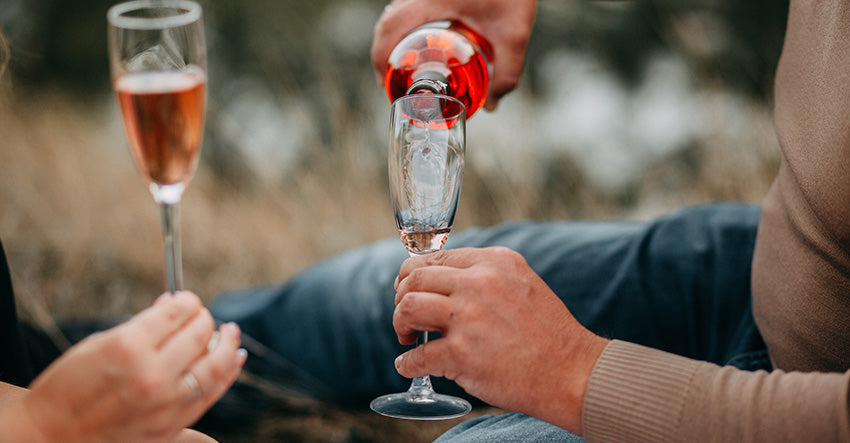
Other Rosé Tips
Though typically an affordable wine (from $10,) rosé can be very expensive (up to $100.) Whatever your budget, you will find one you enjoy in your price range.
The gateway wine for Millennials, they love it for its simplicity, color, and price. They adopted it as an affordable “luxury lifestyle” wine and drink it everywhere and all the time, just look at Instagram. Millennials like rosé more than crazy popular prosécco.
Rosé is the perfect wine to dress up any experience, another Millennial draw. They even use it as an ingredient in cocktails.
With its continued popularity, you find more rosé today than ever. However, there are many low-quality wines on the market.
Some producers artificially manipulate the color by adding chemical compounds. They do this to avoid oxidation, which can make the wine appear orange or brown. These compounds can also be used to manipulate the flavor.
For alternatives, search for organic or biodynamic wine producers. Be careful with the term “natural” when applied to wine. This term has no consistent definition so it could mean anything.
You can’t determine the sweetness of rosé from its label. Nor can you know the flavor profile from the color of the wine. You can only learn what a wine tastes like by tasting it, or by asking a wine professional.
Regions with production requirements, such as France and Spain, are excellent choices for quality rosé. Another way to choose is by reputation, such as Santa Barbara County.
South Africa makes lovely MCC (Method Cap Classique) sparkling rosé which is similar to rosé champagne.
Do you need a proper glass for rosé? No, but flutes are nice for sparkling rosé. A white wine glass works fine for still rosé, and a more substantial wine could be served in a chardonnay glass.
Some producers make rosé almost like red wine, high in alcohol. So, watch out for these because you don’t want the pure, refreshing pleasure you expect to turn into an early bedtime.
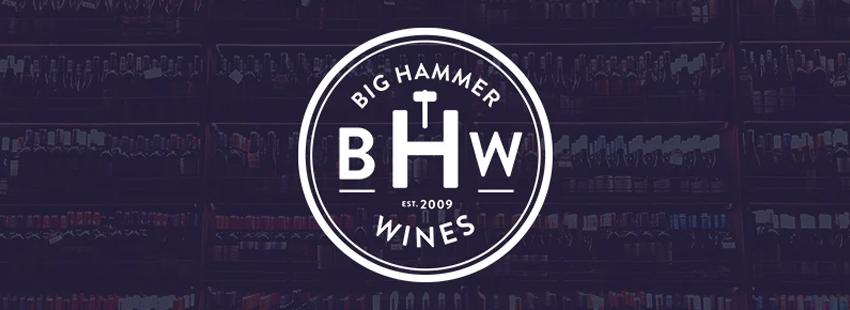
Big Hammer Wines: Your Best Choice for Rosé
Summertime is rosé time, maybe even more so with COVID-19 in our lives. A few moments of summer pleasure with our favorite rosé can remind us to smell the roses.
From Rosé All Day to lovely Santa Barbara County rosé from Martellotto Winery, Big Hammer Wines is your wine expert. We’ll help you discover extraordinary and unusual wine.
By tasting over 4,500 wines every year, BHW creates an ongoing superior and diversified portfolio of wine that is irresistible. Our unique business model uncovers the best new releases from around the world.
With an impressive technology-driven direct-to-consumer (DTC) sales model, BHW improves the distribution channel by reducing costs and inefficiencies, passing savings on to customers.
Big Hammer Wines provides consumers with wine of exceptional quality and value at every price point.
Inc. Magazine has recognized BHW as one of the fastest-growing companies in the U.S.
Big Hammer Wines
The wine experts at Big Hammer Wines taste thousands of wines every year from around the globe, looking for quality and value. This special offer reflects the passion we have for our clients.
Discover the world through its wines, Click Here! Visit Bighammerwines.com and become a wine expert!


